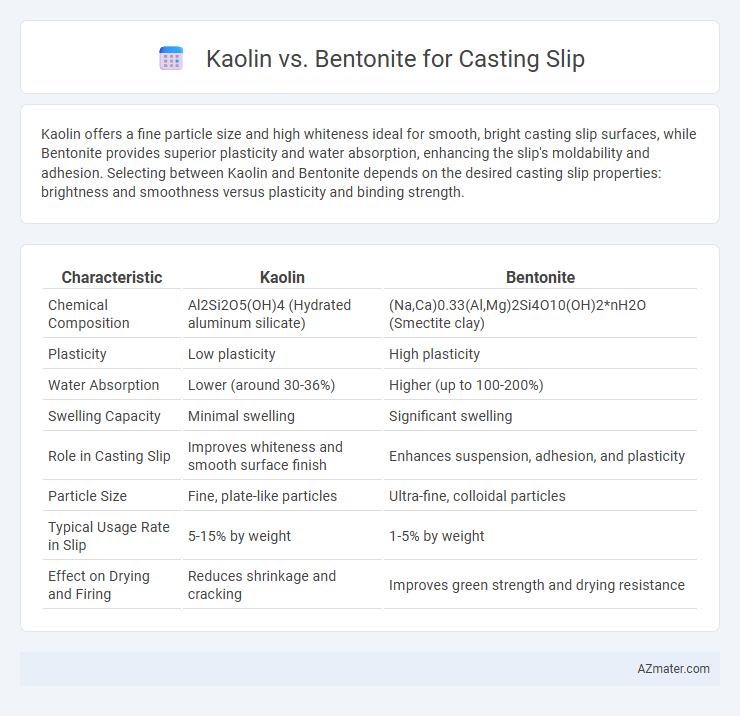Kaolin offers a fine particle size and high whiteness ideal for smooth, bright casting slip surfaces, while Bentonite provides superior plasticity and water absorption, enhancing the slip's moldability and adhesion. Selecting between Kaolin and Bentonite depends on the desired casting slip properties: brightness and smoothness versus plasticity and binding strength.
Table of Comparison
| Characteristic | Kaolin | Bentonite |
|---|---|---|
| Chemical Composition | Al2Si2O5(OH)4 (Hydrated aluminum silicate) | (Na,Ca)0.33(Al,Mg)2Si4O10(OH)2*nH2O (Smectite clay) |
| Plasticity | Low plasticity | High plasticity |
| Water Absorption | Lower (around 30-36%) | Higher (up to 100-200%) |
| Swelling Capacity | Minimal swelling | Significant swelling |
| Role in Casting Slip | Improves whiteness and smooth surface finish | Enhances suspension, adhesion, and plasticity |
| Particle Size | Fine, plate-like particles | Ultra-fine, colloidal particles |
| Typical Usage Rate in Slip | 5-15% by weight | 1-5% by weight |
| Effect on Drying and Firing | Reduces shrinkage and cracking | Improves green strength and drying resistance |
Introduction to Casting Slip Materials
Kaolin and bentonite are essential clay minerals used in casting slip formulations for ceramics. Kaolin provides whiteness, plasticity, and refractory properties, improving the slip's ability to form fine details and withstand high temperatures. Bentonite enhances suspension and rheological properties by increasing viscosity and water absorption, ensuring a smooth, stable slip for casting processes.
What is Kaolin?
Kaolin is a fine, white clay mineral primarily composed of the mineral kaolinite, widely used in ceramics for its plasticity and purity. In casting slip formulations, kaolin provides excellent suspension and smoothness, enhancing the cast's strength and surface finish. Its low shrinkage and high refractory properties make it ideal for detailed molds and reducing cracking during drying and firing.
What is Bentonite?
Bentonite is a natural clay composed primarily of montmorillonite, known for its excellent swelling properties and strong adsorption capabilities, making it essential in casting slips for Improving plasticity and water retention. Bentonite enhances the rheological properties of casting slips by increasing viscosity and improving particle suspension, which results in smoother mold surfaces and reduced defects. Its unique ability to absorb water and expand contributes to better mold filling, shrinkage control, and overall casting quality compared to kaolin.
Chemical Composition Comparison
Kaolin primarily consists of the mineral kaolinite with the chemical formula Al2Si2O5(OH)4, characterized by low plasticity and high whiteness, making it ideal for casting slips requiring smooth surfaces. Bentonite is chiefly composed of montmorillonite, a smectite group clay with a formula roughly (Na,Ca)0.33(Al,Mg)2Si4O10(OH)2*nH2O, notable for its high swelling capacity and plasticity that enhances workability but may affect slip drying properties. The distinct differences in alumina, silica, and water content between kaolin and bentonite significantly influence slip rheology and final ceramic quality.
Particle Size and Plasticity Differences
Kaolin particles are typically finer and more uniform, contributing to a smoother casting slip with lower plasticity compared to bentonite. Bentonite possesses larger, plate-like particles that provide greater plasticity and water absorption, enhancing slip cohesion and workability during casting. The particle size and shape differences directly impact the flow properties and drying behavior of ceramic slips in mold applications.
Water Absorption in Kaolin vs Bentonite
Kaolin exhibits lower water absorption compared to bentonite, making it ideal for ceramic casting slips requiring less shrinkage and higher density. Bentonite's high water absorption capacity improves slip plasticity and suspension but can increase drying time and final porosity. Optimizing water absorption balances casting slip fluidity and mechanical strength, where kaolin provides stability and bentonite enhances workability.
Suspension and Workability Factors
Kaolin enhances casting slip suspension by providing a finer particle size that improves fluidity and reduces settling, resulting in a smoother pour. Bentonite offers superior workability due to its higher swelling capacity and plasticity, creating a more cohesive slip that maintains shape during casting. The combination of kaolin's suspension benefits and bentonite's rheological improvements optimizes slip stability and ease of use in ceramic casting applications.
Influence on Casting Slip Properties
Kaolin enhances casting slip properties by improving flowability and reducing shrinkage due to its fine particle size and plate-like structure, which promotes better particle packing. Bentonite increases viscosity and plasticity through its high swelling capacity and layered silicate structure, aiding in the suspension of solids and improving green strength of casts. The choice between kaolin and bentonite significantly influences slip rheology, drying behavior, and final cast strength.
Cost and Availability Considerations
Kaolin and bentonite serve distinct roles in casting slip, with kaolin typically costing more due to its refined purity and controlled particle size, which enhances slip consistency and surface finish. Bentonite is generally more affordable and widely available, offering excellent plasticity and water retention properties that improve mold release but may require higher quantities for similar effects. Availability can vary regionally, favoring bentonite in areas with abundant clay deposits, while kaolin sourcing depends on specialized mining operations, impacting overall project budgets.
Choosing the Right Clay for Your Casting Slip
Selecting the right clay for casting slip depends on desired properties such as plasticity, smoothness, and drying time. Kaolin offers purity and smoothness, ideal for fine-detail work and whiteware ceramics, while bentonite provides superior plasticity and better suspension, enhancing slip stability and workability. For casting slip applications requiring consistent flow and strong green strength, bentonite is often preferred, whereas kaolin suits refined finishes and delicate casting molds.

Infographic: Kaolin vs Bentonite for Casting Slip
 azmater.com
azmater.com